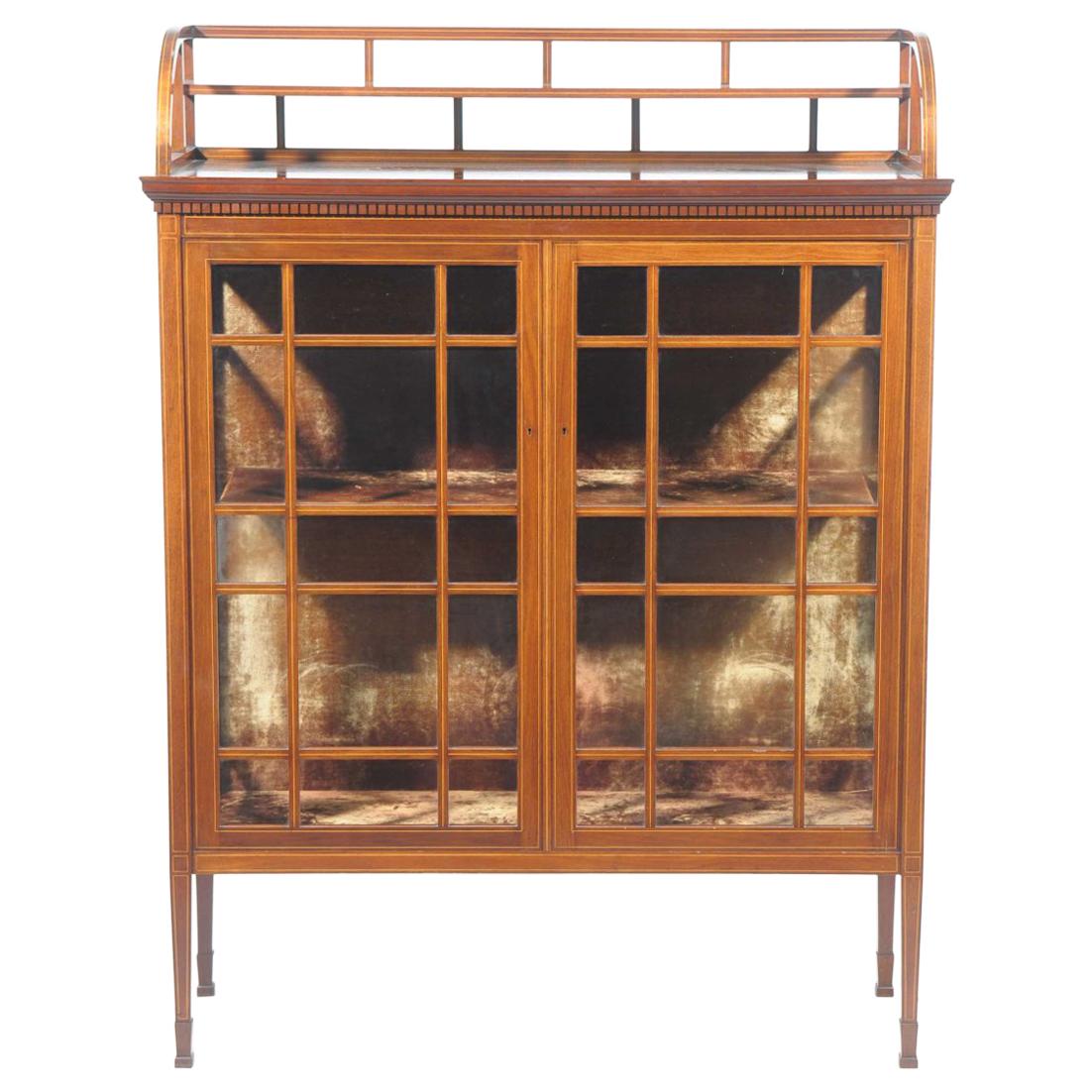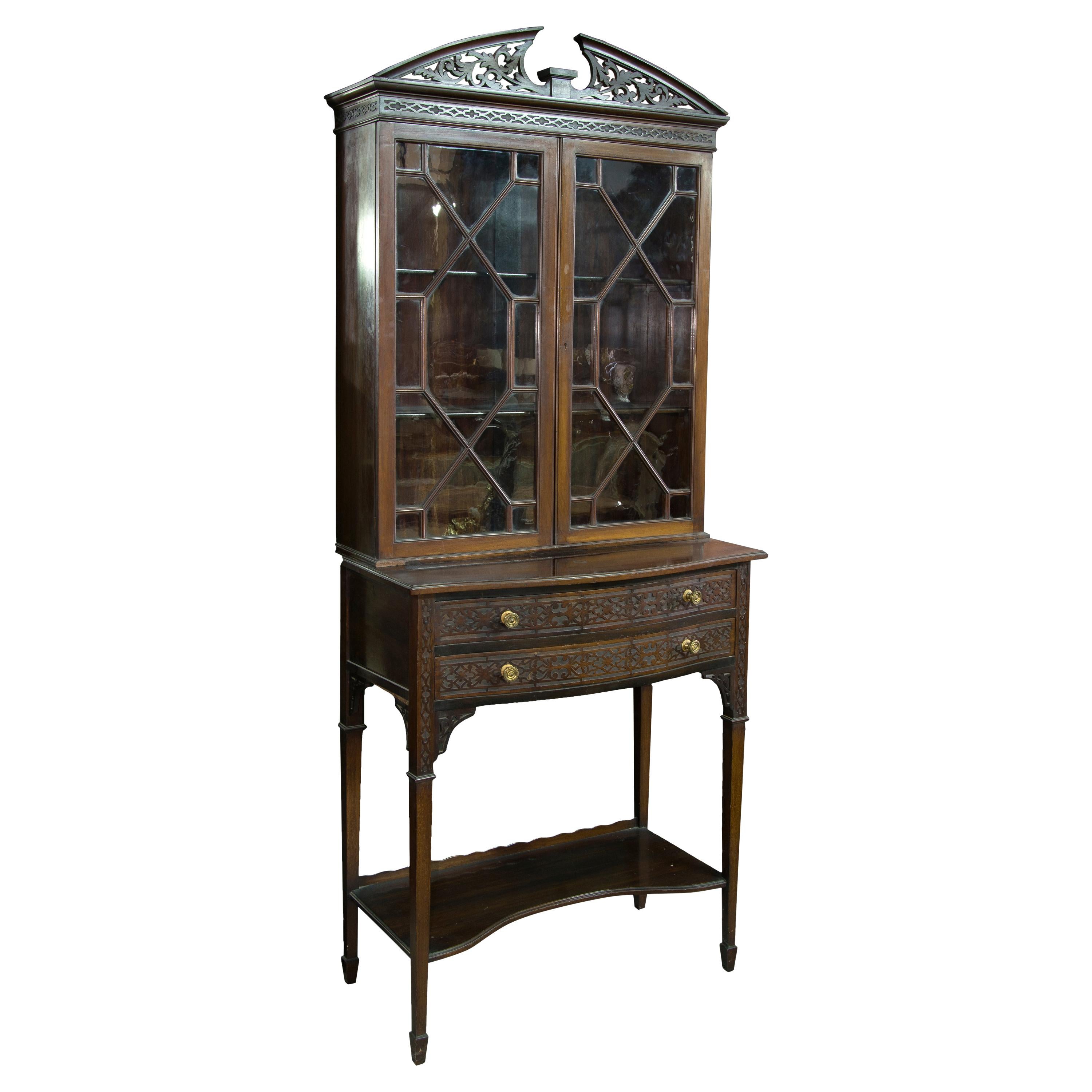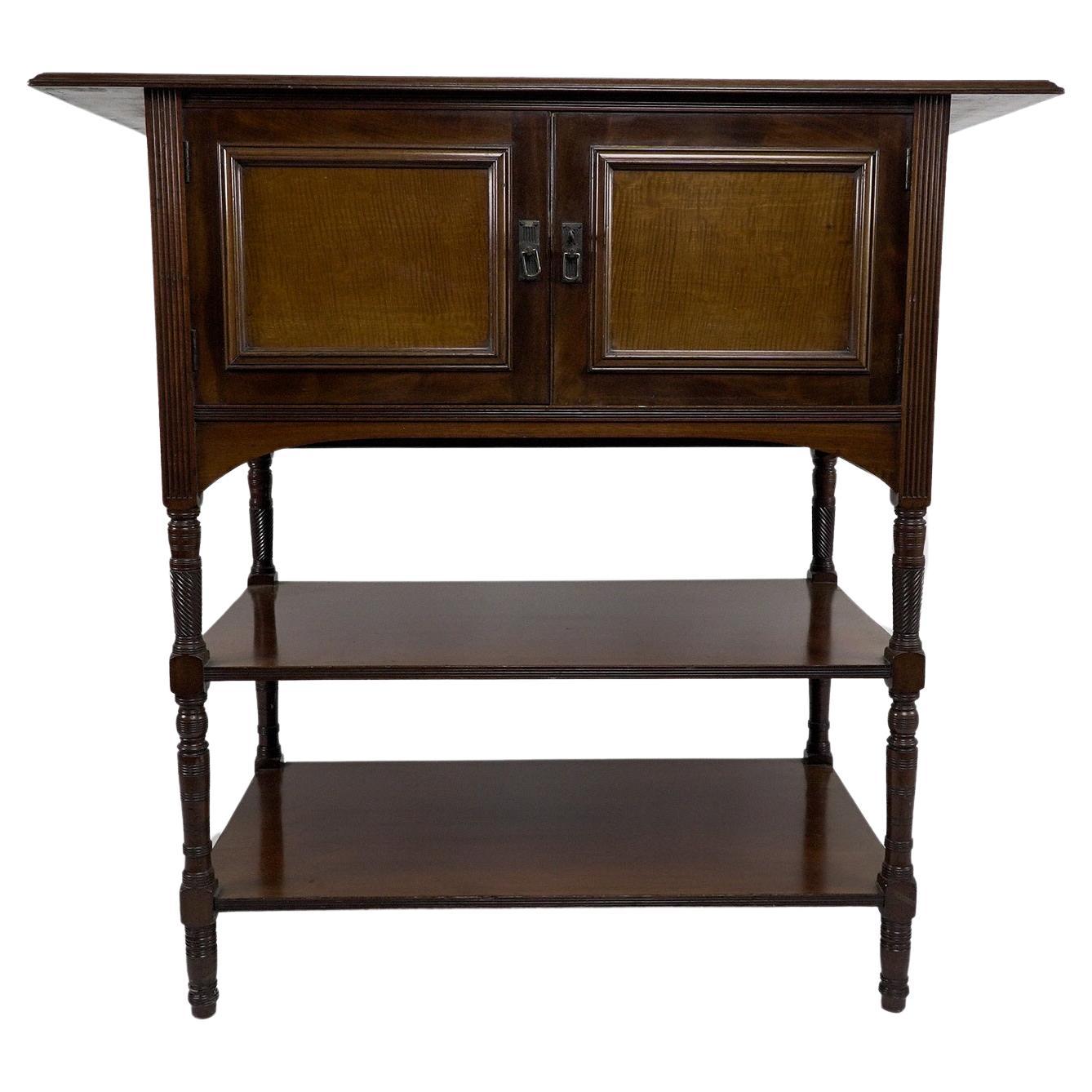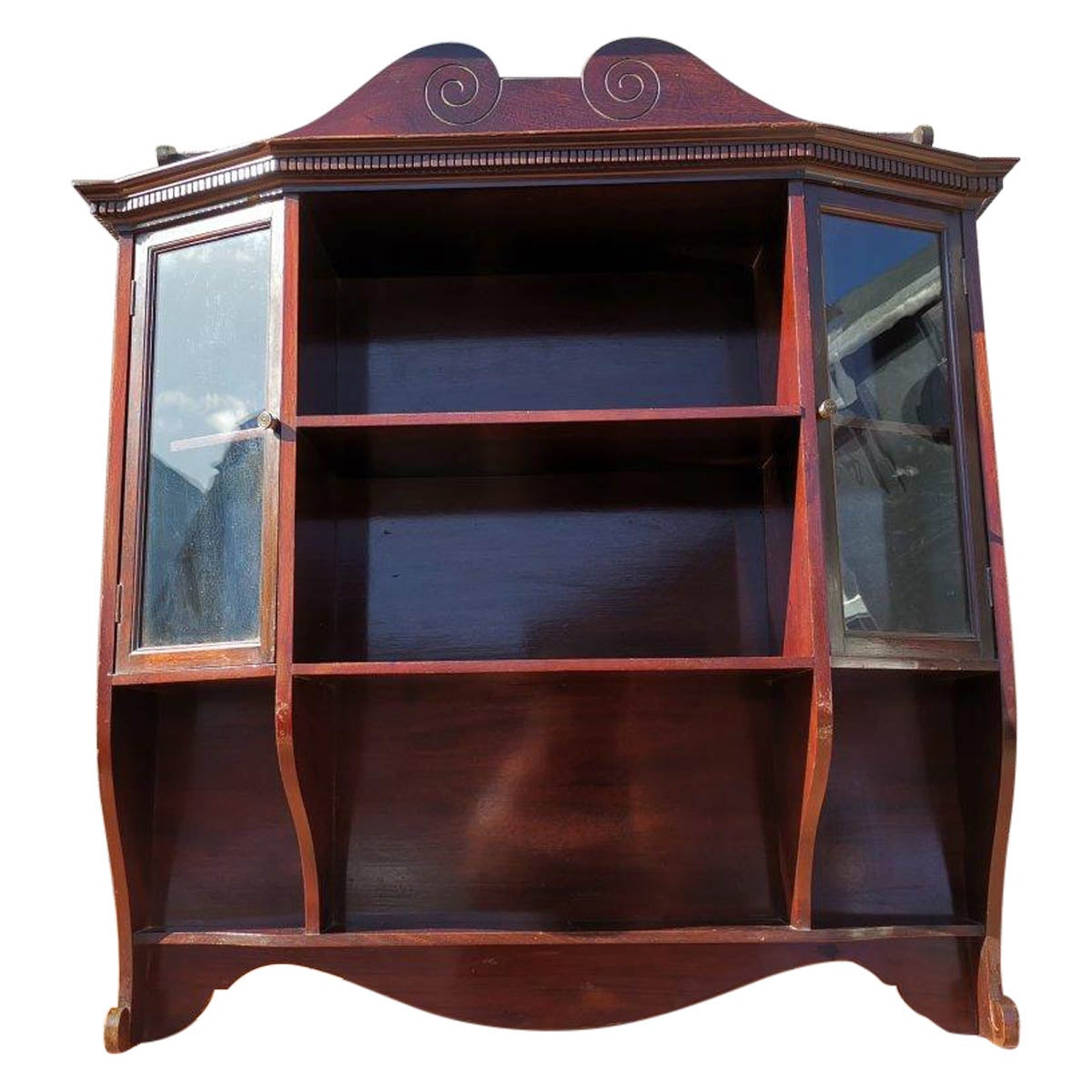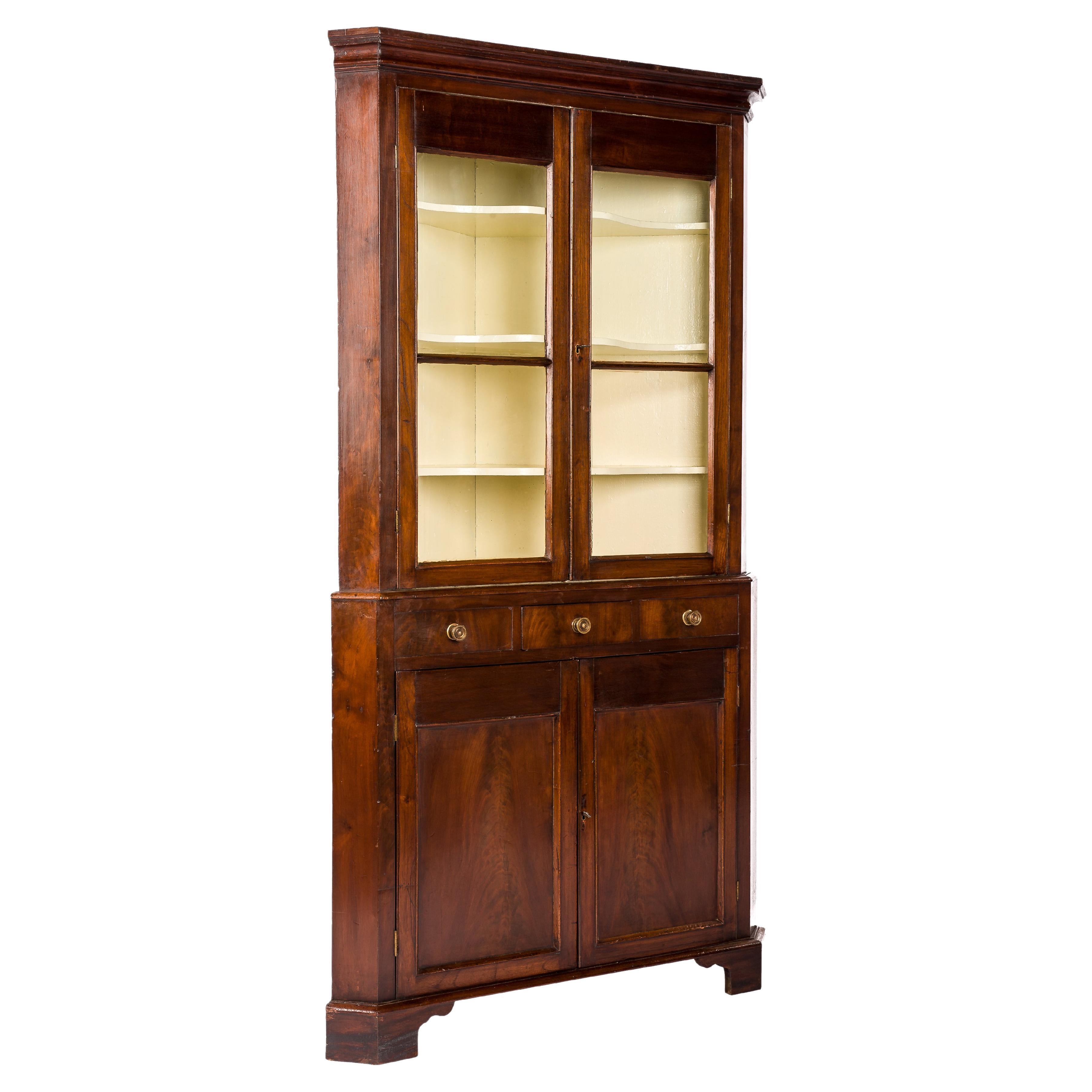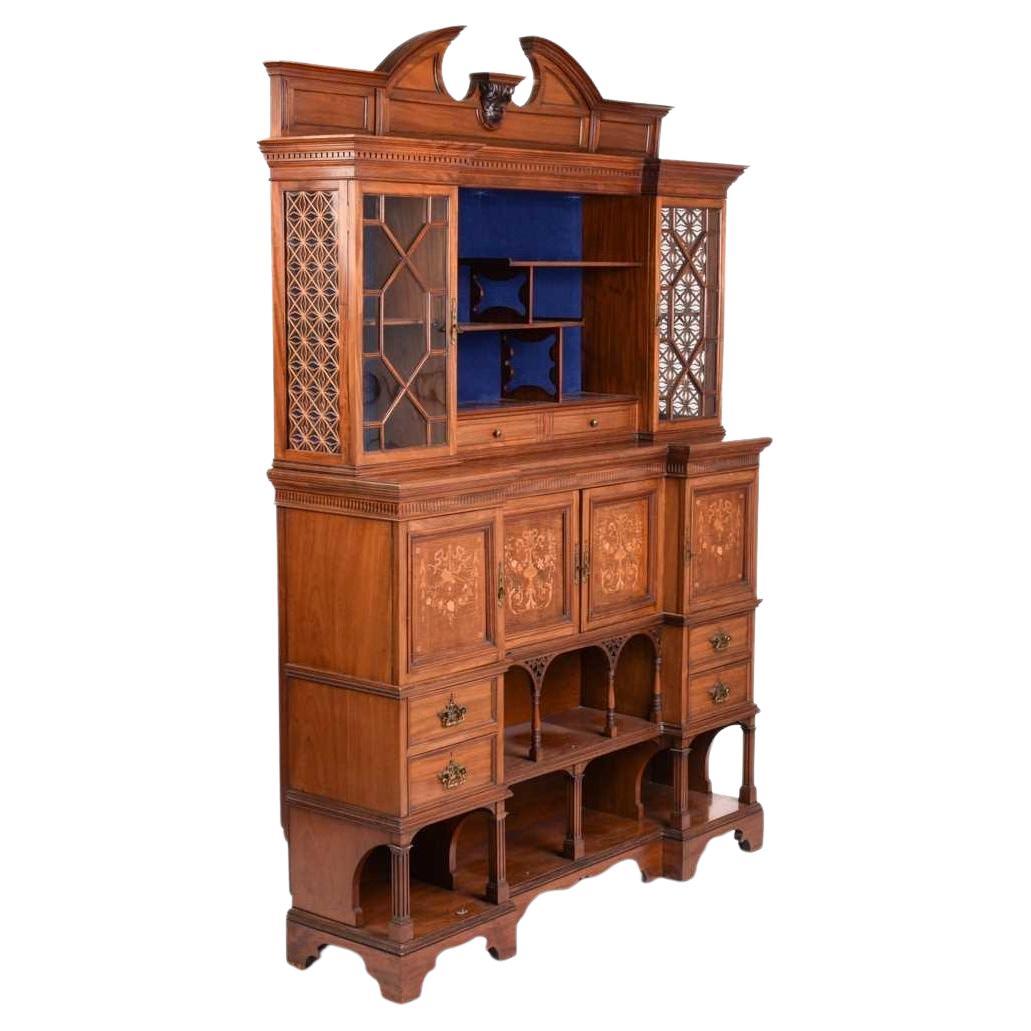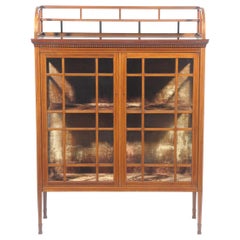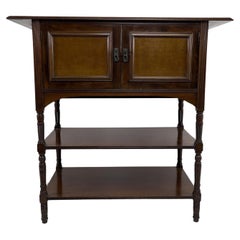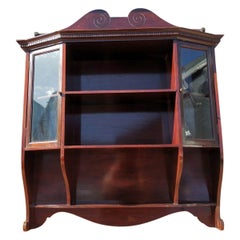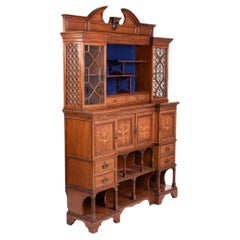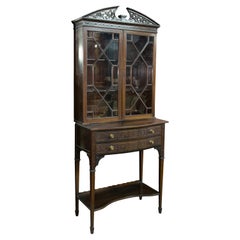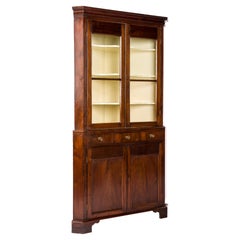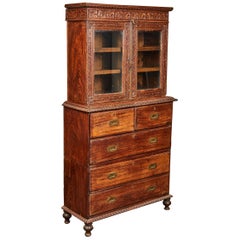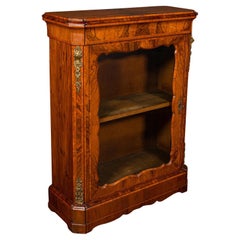Items Similar to Collinson & Lock. Aesthetic Movement Anglo-Japanese Glazed Walnut Side Cabinet
Want more images or videos?
Request additional images or videos from the seller
1 of 17
Collinson & Lock. Aesthetic Movement Anglo-Japanese Glazed Walnut Side Cabinet
$8,167.49
£6,000
€7,053.79
CA$11,468.06
A$12,568.64
CHF 6,563.58
MX$150,809.22
NOK 82,417.01
SEK 77,633.77
DKK 52,673.79
About the Item
Collinson & Lock.
An outstanding quality Aesthetic Movement Anglo-Japanese walnut side cabinet with dentil moulding to the cornice and astragal glazed upper doors opening to reveal a luscious blue velvet interior with highly decorated handle back plates depicting Japanese basket weave with floral plumes and wonderful scroll work elongated drop handles, with a small work area and three bow fronted drawers below, each with half moon drop handles with sunflower rosette circular brass back plates. The whole on four tapering square legs united by an inverted lower shelf on spear head feet.
Collinson and Lock of London 'Art Furnishers', founded with the partnership of F.G. Collinson and G.J. Lock, former employees of Jackson and Graham. Designers employed by the firm included T.E. Collcutt, the architect of their premises; E.W. Godwin, who was paid a retainer to produce exclusive designs for the company from 1872-1874, H.W. Batley and Stephen Webb. They made furniture for the new Law Courts to designs by G.E. Street, along with Gillows and Holland and Sons, and began decoration of the Savoy Theatre in 1881. Jackson and Graham was taken over in 1885, at the time when the firm had moved to Oxford Street and begun to focus on expensive commissions for grandiose London houses. The firm was taken over by Gillows in 1897. The firm of Collinson and Lock was established in London in the third quarter of the 19th century and quickly achieved both commercial success and a leading position in the field of design. In 1871 the firm issued an impressive illustrated catalogue of 'Artistic furniture', with plates by J. Moyar Smith, assistant to Christopher Dresser, and in 1873 was trading from extensive newly built premises in St Bride Street. The firm continued to produce very high quality items of furniture and soon began to experiment with new materials and designs, becoming especially renowned for their distinctive combinations of rosewood and ivory and their intricate Italianate arabesques, traditional figures and scrolling foliage. This form of decoration clearly points toward the involvement of Stephen Webb, Collinson and Locks chief designer who was later appointed Professor of Sculpture at the Royal College of Art.
E.W.Godwin was their most important designer and so advanced were his designs in the Japanese style.
- Creator:Collinson & Lock (Maker)
- Dimensions:Height: 70 in (177.8 cm)Width: 32 in (81.28 cm)Depth: 19 in (48.26 cm)
- Style:Aesthetic Movement (Of the Period)
- Materials and Techniques:
- Place of Origin:
- Period:
- Date of Manufacture:1880
- Condition:Wear consistent with age and use.
- Seller Location:London, GB
- Reference Number:1stDibs: LU2243322089012
About the Seller
5.0
Platinum Seller
Premium sellers with a 4.7+ rating and 24-hour response times
Established in 1989
1stDibs seller since 2016
300 sales on 1stDibs
Typical response time: <1 hour
- ShippingRetrieving quote...Shipping from: London, United Kingdom
- Return Policy
Authenticity Guarantee
In the unlikely event there’s an issue with an item’s authenticity, contact us within 1 year for a full refund. DetailsMoney-Back Guarantee
If your item is not as described, is damaged in transit, or does not arrive, contact us within 7 days for a full refund. Details24-Hour Cancellation
You have a 24-hour grace period in which to reconsider your purchase, with no questions asked.Vetted Professional Sellers
Our world-class sellers must adhere to strict standards for service and quality, maintaining the integrity of our listings.Price-Match Guarantee
If you find that a seller listed the same item for a lower price elsewhere, we’ll match it.Trusted Global Delivery
Our best-in-class carrier network provides specialized shipping options worldwide, including custom delivery.More From This Seller
View AllE W Godwin, Collinson & Lock, an Anglo Japanese Mahogany and Satinwood Cabinet
By Collinson & Lock, Edward William Godwin
Located in London, GB
Edward William Godwin. Made by Collinson & Lock.
A fine quality Anglo Japanese mahogany and astragal glazed cabinet with satinwood line inlay.
...
Category
Antique 1870s English Anglo-Japanese Cabinets
Materials
Mahogany, Satinwood
Collinson & Lock EW Godwin attri. An Aesthetic Movement walnut side cabinet.
By Collinson & Lock
Located in London, GB
Collinson and Lock EW Godwin attributed. An Aesthetic Movement Mahogany side cabinet, the upper cupboard doors with contrasting fruit wood panels and little ...
Category
Antique 1870s English Aesthetic Movement Sideboards
Materials
Mahogany
Collinson & Lock an English Aesthetic Movement Mahogany Glazed Wall Cabinet
By Collinson & Lock
Located in London, GB
Collinson and Lock London. 103. Stamped to the back.
An English Aesthetic Movement Mahogany glazed wall cabinet with incised scrollwork sw...
Category
Antique 1880s English Aesthetic Movement Shelves and Wall Cabinets
Materials
Glass, Mahogany
Collinson and Lock attributed. A rare Anglo-Japanese inverted mahogany sideboard
By Collinson & Lock
Located in London, GB
An Anglo-Japanese inverted mahogany sideboard, the arched open cornice with a small central carved display bracket to the centre, and an upper display shelf, a dentil cornice below w...
Category
Antique 1880s English Anglo-Japanese Sideboards
Materials
Walnut
George Jack Morris & Co. Two Aesthetic Movement Walnut glazed corner cabinets.
By George Jack, Morris & Co.
Located in London, GB
George Jack for Morris and Co. Stamped Morris and Co. 449 Oxford Street. Two matching Aesthetic Movement Walnut glazed corner cabinets, each with an open display area to the top and ...
Category
Antique 1890s English Arts and Crafts Corner Cupboards
Materials
Walnut
Gregory & Co, H W Batley Attri, an English Walnut Aesthetic Movement Sideboard
By Henry William Batley, Gregory & Co. 1
Located in London, GB
Gregory and Co. Regent Street. London. Stamped mark to a door, and no. 1479.
H W Batley attributed.
An English walnut Aesthetic Movement sideboard with a t...
Category
Antique 1870s English Aesthetic Movement Sideboards
Materials
Brass
You May Also Like
English Mahogany Showcase Cabinet, 19th Century
Located in Madrid, ES
English showcase. Mahogany wood, XIX century.
Showcase with shelves and two doors with glass and geometric decoration topped by a split pediment wi...
Category
Antique 19th Century English Neoclassical Cabinets
Materials
Metal
Antique Early 19th Century English Regency Mahogany Glazed Corner Cupboard
Located in Casteren, NL
This beautiful antique glazed corner cupboard was made in the United Kingdom in the early 19th century circa 1820. The cupboard breaks d...
Category
Antique Early 19th Century British Regency Cupboards
Materials
Brass
$4,960 Sale Price
20% Off
19th Century British Colonial Rosewood Display Cabinet
Located in San Marino, CA
19th century Goa rosewood display cabinet with sunburst design on doors. Two small drawers with three large below. Keys included.
Category
Antique 19th Century Indian British Colonial Cabinets
Materials
Rosewood
Large Antique Pier Cabinet, English, Walnut, Glazed, Druce & Co, Victorian, 1850
Located in Hele, Devon, GB
This is a large antique pier cabinet. An English, walnut glazed display cupboard by Druce & Co, dating to the early Victorian period, circa 1850.
Superior Victorian craftsmanship w...
Category
Antique Mid-19th Century British Early Victorian Cabinets
Materials
Walnut
Late 19th C English Mahogany Cupboard with Glazed Top
Located in Troy, MI
Found in England, this mahogany cupboard dates from the 1870s. Cabinet has locking glazed doors on the top with three adjustable shelves on each side. Three functional drawers and lo...
Category
Antique Late 19th Century English Cupboards
Materials
Glass, Mahogany
Antique Victorian Quality Carved Mahogany Display Cabinet
Located in Suffolk, GB
Antique Victorian quality carved mahogany display cabinet having a quality carved pediment above a pair of astral glazed doors opening to reveal two adjustable display shelves suppor...
Category
Antique 19th Century English Victorian Cabinets
Materials
Other
More Ways To Browse
Japanese Kitchen Cabinet
Holland And Son
Walnut Japanese
Antique Glazed Kitchen Cabinets
Walnut Dresser With Brass Handles
Collinson And Lock
Japanese Weaving
Jackson And Graham
H W Batley
Lock Of London
Sunflower Plates
Vintage Brass And Glass Display Case
French Display Cases
French Mirrored Cabinet
Used Filing Cabinets
Curved Doors
Hanging Cabinet
Antique Arched Door
